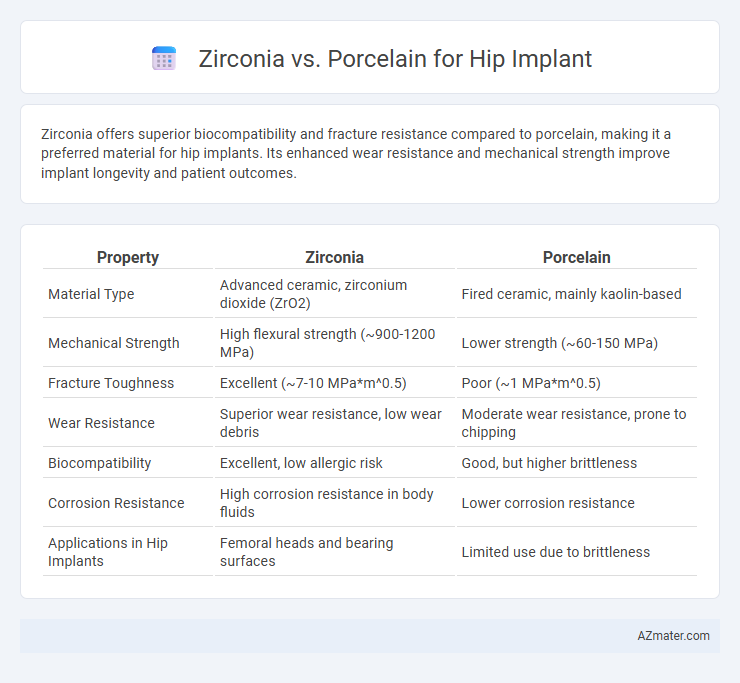Zirconia offers superior biocompatibility and fracture resistance compared to porcelain, making it a preferred material for hip implants. Its enhanced wear resistance and mechanical strength improve implant longevity and patient outcomes.
Table of Comparison
| Property | Zirconia | Porcelain |
|---|---|---|
| Material Type | Advanced ceramic, zirconium dioxide (ZrO2) | Fired ceramic, mainly kaolin-based |
| Mechanical Strength | High flexural strength (~900-1200 MPa) | Lower strength (~60-150 MPa) |
| Fracture Toughness | Excellent (~7-10 MPa*m^0.5) | Poor (~1 MPa*m^0.5) |
| Wear Resistance | Superior wear resistance, low wear debris | Moderate wear resistance, prone to chipping |
| Biocompatibility | Excellent, low allergic risk | Good, but higher brittleness |
| Corrosion Resistance | High corrosion resistance in body fluids | Lower corrosion resistance |
| Applications in Hip Implants | Femoral heads and bearing surfaces | Limited use due to brittleness |
Introduction: Zirconia vs Porcelain in Hip Implants
Zirconia and porcelain are two prominent materials used in hip implants, with zirconia offering superior strength and fracture resistance compared to porcelain. Zirconia's biocompatibility and toughness make it a preferred choice for load-bearing applications, while porcelain is generally valued for its aesthetic qualities but lacks the mechanical durability required for hip implants. Recent studies highlight zirconia's advantage in wear resistance and longevity, positioning it as the more effective option for durable hip replacement components.
Material Composition and Properties
Zirconia hip implants consist primarily of zirconium dioxide, offering exceptional strength, toughness, and biocompatibility, which reduce wear and risk of fracture compared to traditional materials. Porcelain, primarily composed of kaolin, feldspar, and silica, lacks the mechanical robustness and fracture resistance required for load-bearing hip implants, making it unsuitable for such applications. Zirconia's superior hardness and resistance to corrosion and fatigue contribute to its preference over porcelain for durable, long-lasting hip prosthetics.
Mechanical Strength and Durability
Zirconia hip implants exhibit superior mechanical strength and durability compared to porcelain due to their high fracture toughness and resistance to wear under cyclic loading. Porcelain, while biocompatible, shows lower tensile strength and higher brittleness, increasing the risk of microcracks and failure in high-stress environments. The advanced toughness of zirconia facilitates longer implant lifespan and reduced risk of mechanical degradation in hip joint applications.
Biocompatibility and Safety
Zirconia hip implants exhibit superior biocompatibility due to their inert ceramic composition, minimizing immune response and reducing the risk of inflammation compared to porcelain alternatives. Porcelain, while aesthetically similar, lacks the mechanical strength and durability required for load-bearing applications, increasing susceptibility to wear debris and potential cytotoxicity. Zirconia's enhanced fracture toughness and chemical stability contribute to safer long-term outcomes in hip implant performance.
Wear Resistance and Longevity
Zirconia exhibits superior wear resistance compared to porcelain, making it a preferred material for hip implants due to its ability to withstand high mechanical stress without significant degradation. The enhanced longevity of zirconia components is attributed to their high fracture toughness and biocompatibility, reducing the risk of implant failure over time. Porcelain, while historically used, demonstrates lower durability and increased wear, leading to a higher likelihood of revision surgeries in hip replacements.
Clinical Performance and Success Rates
Zirconia hip implants demonstrate superior clinical performance and longer success rates due to their enhanced biocompatibility, wear resistance, and fracture toughness compared to porcelain-based implants. Studies indicate lower incidence of implant loosening and reduced osteolysis with zirconia, resulting in improved patient outcomes and implant longevity. Porcelain implants, while historically utilized, exhibit higher brittleness and wear, leading to increased failure rates and revision surgeries over time.
Potential Risks and Complications
Zirconia hip implants pose potential risks such as material fatigue and rare cases of fracture, while porcelain implants may suffer from brittleness and higher wear rates leading to debris generation. Both materials can cause adverse tissue reactions, with zirconia showing better biocompatibility but possible sensitivity concerns. Understanding the long-term biostability and fracture resistance of zirconia versus porcelain remains critical in minimizing postoperative complications.
Aesthetic Considerations in Hip Implants
Zirconia hip implants offer superior aesthetic appeal due to their natural white color and ability to resist discoloration over time, which closely mimics the appearance of natural bone. Porcelain implants, while also aesthetically pleasing, tend to be more brittle and susceptible to chipping or discoloration, impacting long-term visual outcomes. The durability and color stability of zirconia make it a preferred choice for patients seeking implants with lasting, natural-looking aesthetics.
Cost Comparison and Accessibility
Zirconia hip implants typically cost more than porcelain options due to advanced manufacturing processes and superior durability. Porcelain implants are more widely accessible and affordable, making them a preferred choice in regions with budget constraints. Cost differences influence patient selection, with zirconia favored in premium healthcare settings for its longevity despite higher expenses.
Future Trends and Innovations
Zirconia hip implants exhibit superior biocompatibility and fracture resistance compared to porcelain, driving ongoing research into enhanced durability and wear reduction. Future trends emphasize nano-engineered zirconia composites and advanced surface coatings to improve osseointegration and reduce inflammatory responses. Innovations in 3D printing and biomimetic design aim to customize zirconia implants for patient-specific anatomy, potentially revolutionizing hip replacement therapies.

Infographic: Zirconia vs Porcelain for Hip implant
 azmater.com
azmater.com